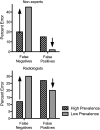HOW DO RADIOLOGISTS USE THE HUMAN SEARCH ENGINE?
- PMID: 26656078
- PMCID: PMC4911962
- DOI: 10.1093/rpd/ncv501
HOW DO RADIOLOGISTS USE THE HUMAN SEARCH ENGINE?
Abstract
Radiologists perform many 'visual search tasks' in which they look for one or more instances of one or more types of target item in a medical image (e.g. cancer screening). To understand and improve how radiologists do such tasks, it must be understood how the human 'search engine' works. This article briefly reviews some of the relevant work into this aspect of medical image perception. Questions include how attention and the eyes are guided in radiologic search? How is global (image-wide) information used in search? How might properties of human vision and human cognition lead to errors in radiologic search?
© The Author 2015. Published by Oxford University Press. All rights reserved. For Permissions, please email: journals.permissions@oup.com.
Figures




References
-
- Burgess A. E. Spatial vision research without noise. In: The Handbook of Medical Image Perception and Techniques. Samei E., Krupinski E. A., Eds. Cambridge University Press; (2010).
-
- Bricolo E., Gianesini T., Fanini A., Bundesen C., Chelazzi L.. Serial attention mechanisms in visual search: a direct behavioral demonstration. J. Cogn. Neurosci. 14, 980–993 (2002). - PubMed
-
- Nothdurft H. C. Texture segmentation and pop-out from orientation contrast. Vision Res. 31, 1073–1078 (1991). - PubMed
-
- Nothdurft H. C. Feature analysis and the role of similarity in preattentive vision. Percept. Psychophys. 52, 355–375 (1992). - PubMed
Publication types
MeSH terms
LinkOut - more resources
Full Text Sources
Other Literature Sources
Medical

